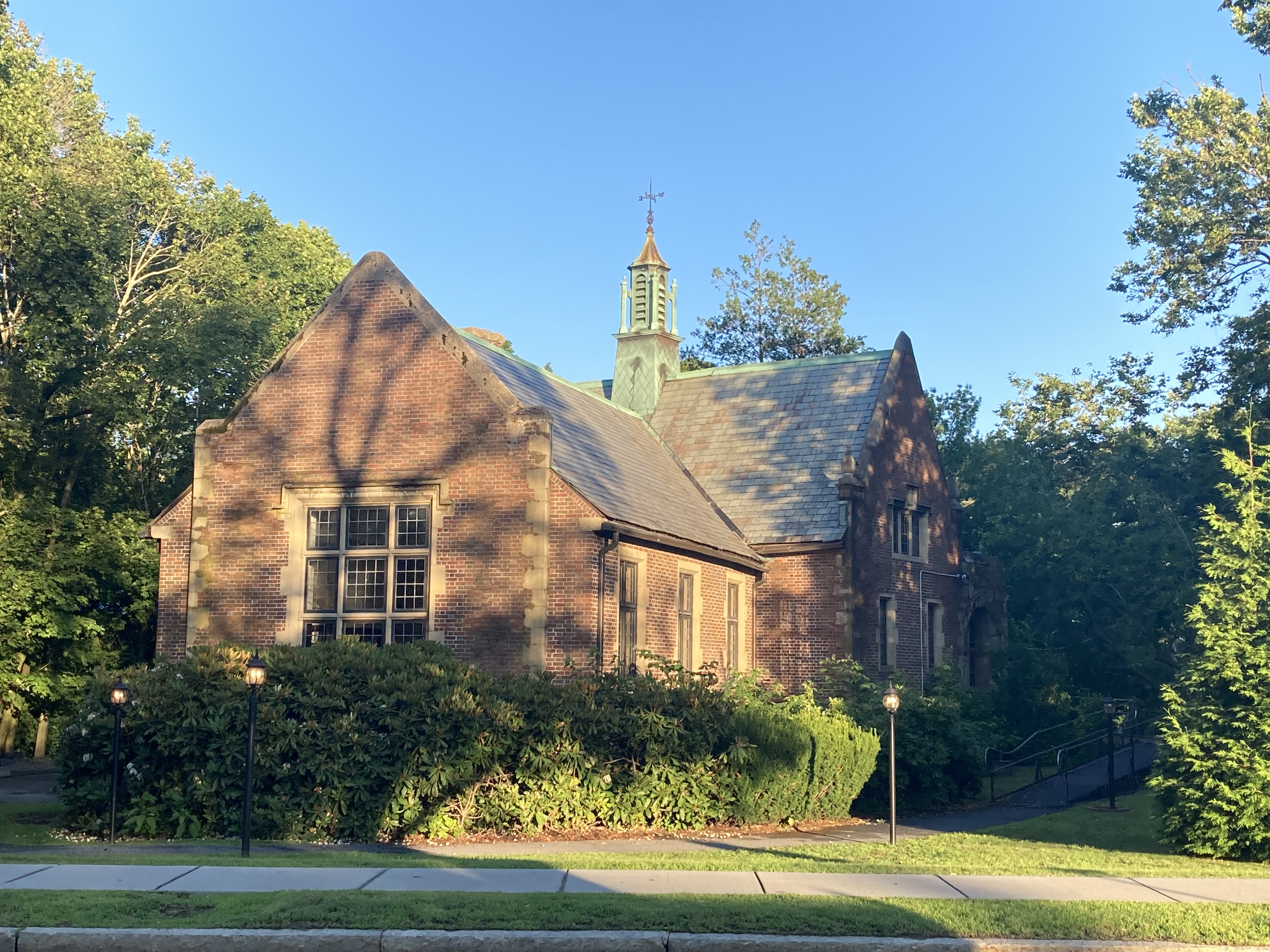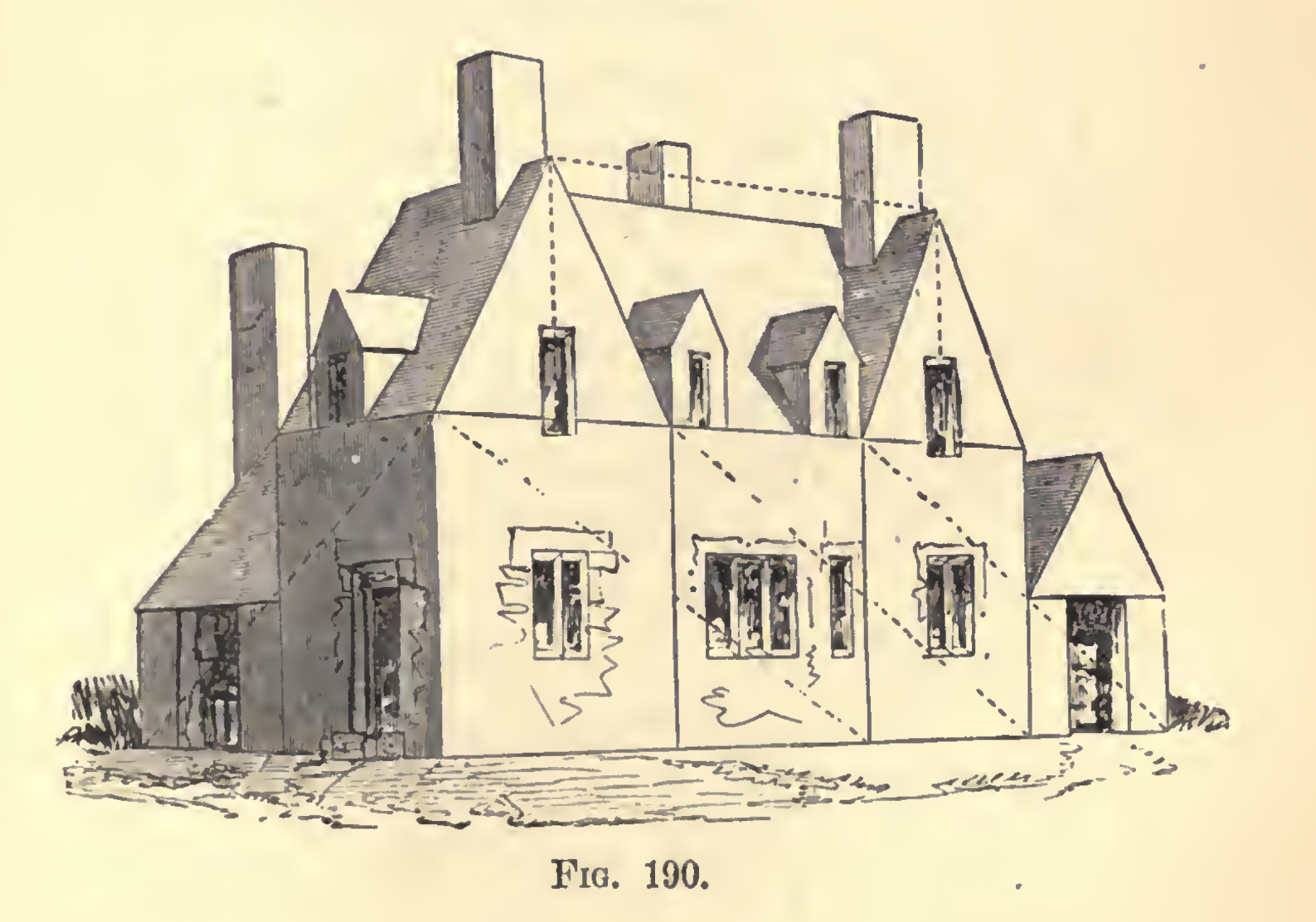|
Windsor Road Historic District
The Windsor Road Historic District is a residential historic district just north of the village of Waban in Newton, Massachusetts.It includes 48 houses on Windsor, Kent and Hereford Roads, a cul-de-sac subdivision adjacent to the village center and the Brae Burn Country Club, which was mostly developed between 1888 and 1920.It was added to the National Register of Historic Places in 1990. Description and history The Windsor Road area was among the landholdings of William Strong, a farmer and real estate developer, who acquired in 1875. He actively promoted the construction of the Circuit Railroad (now the MBTA Green Line D branch), which arrived in 1888, and formed the nucleus of Waban village. Strong laid roads out on his land, and between 1888 and 1907 fifteen houses were built on Windsor Road. By 1950, the area was built out by the addition of another twenty houses, and by construction of the Brae Burn Country Club. Windsor Road extends northward from the center of Waban vil ... [...More Info...] [...Related Items...] OR: [Wikipedia] [Google] [Baidu] |
Newton, Massachusetts
Newton is a city in Middlesex County, Massachusetts, United States. It is approximately west of downtown Boston. Newton resembles a patchwork of thirteen villages, without a city center. According to the 2020 U.S. Census, the population of Newton was 88,923. History Newton was settled in 1630 as part of "the newe towne", which was renamed Cambridge in 1638. Roxbury minister John Eliot persuaded the Native American people of Nonantum, a sub-tribe of the Massachusett led by a sachem named Waban, to relocate to Natick in 1651, fearing that they would be exploited by colonists. Newton was incorporated as a separate town, known as Cambridge Village, on December 15, 1681, then renamed Newtown in 1691, and finally Newton in 1766. It became a city on January 5, 1874. Newton is known as ''The Garden City''. In ''Reflections in Bullough's Pond'', Newton historian Diana Muir describes the early industries that developed in the late 18th and early 19th centuries in a series of mills b ... [...More Info...] [...Related Items...] OR: [Wikipedia] [Google] [Baidu] |
American Craftsman
American Craftsman is an American domestic architectural style, inspired by the Arts and Crafts movement, which included interior design, landscape design, applied arts, and decorative arts, beginning in the last years of the 19th century. Its immediate ancestors in American architecture are the Shingle style architecture, Shingle style, which began the move away from Victorian ornamentation toward simpler forms; and the Prairie style of Frank Lloyd Wright. The name "Craftsman" was appropriated from furniture-maker Gustav Stickley, whose magazine ''The Craftsman'' was first published in 1901. The architectural style was most widely used in small-to-medium-sized Southern California single-family homes from about 1905, so that the smaller-scale Craftsman style became known alternatively as " California bungalow". The style remained popular into the 1930s, and has continued with revival and restoration projects through present times. Influences The American Craftsman style was ... [...More Info...] [...Related Items...] OR: [Wikipedia] [Google] [Baidu] |
Historic District (United States)
Historic districts in the United States are designated historic districts recognizing a group of buildings, Property, properties, or sites by one of several entities on different levels as historically or architecturally significant. Buildings, structures, objects and sites within a historic district are normally divided into two categories, Contributing property, contributing and non-contributing. Districts vary greatly in size: some have hundreds of structures, while others have just a few. The U.S. federal government designates historic districts through the United States Department of the Interior, United States Department of Interior under the auspices of the National Park Service. Federally designated historic districts are listed on the National Register of Historic Places, but listing usually imposes no restrictions on what property owners may do with a designated property. U.S. state, State-level historic districts may follow similar criteria (no restrictions) or may req ... [...More Info...] [...Related Items...] OR: [Wikipedia] [Google] [Baidu] |
Waban, Massachusetts
Waban is one of the thirteen List of villages in Newton, Massachusetts, villages within the city of Newton, Massachusetts, Newton in Middlesex County, Massachusetts, Middlesex County, Massachusetts, United States. Geography and history Waban is bordered by the Charles River and Route 9 to the south, and Route 16 to the west. Waban was once a heavily forested area which developed as an agricultural village in the 19th century. By the 1860s, it was known for its orchards, farms and nurseries. The Cochituate Aqueduct, now partly converted to a walking trail, was built in 1846-48 and ran through the village. Development in Waban accelerated after 1886 with the opening of the rail station by the Boston & Albany Railroad as part of the Highland branch, Highland Branch extending to Riverside. Waban is now served by the Massachusetts Bay Transportation Authority, MBTA Green D Line. Origin of name The village of Waban was named for Waban, who is thought to be one of the first members o ... [...More Info...] [...Related Items...] OR: [Wikipedia] [Google] [Baidu] |
National Register Of Historic Places
The National Register of Historic Places (NRHP) is the United States federal government's official list of districts, sites, buildings, structures and objects deemed worthy of preservation for their historical significance or "great artistic value". A property listed in the National Register, or located within a National Register Historic District, may qualify for tax incentives derived from the total value of expenses incurred in preserving the property. The passage of the National Historic Preservation Act (NHPA) in 1966 established the National Register and the process for adding properties to it. Of the more than one and a half million properties on the National Register, 95,000 are listed individually. The remainder are contributing resources within historic districts. For most of its history, the National Register has been administered by the National Park Service (NPS), an agency within the U.S. Department of the Interior. Its goals are to help property owners and inte ... [...More Info...] [...Related Items...] OR: [Wikipedia] [Google] [Baidu] |
MBTA Green Line D Branch
The Green Line D branch (also referred to as the Highland branch or Riverside Line) is a light rail line in Newton, Brookline, and Boston, Massachusetts, operating as part of the Massachusetts Bay Transportation Authority (MBTA) Green Line. The line runs on a grade separated surface right-of-way for from Riverside station to Fenway station. The line merges into the C branch tunnel west of , then follows the Boylston Street subway and Tremont Street subway to . It is the longest and busiest of the four Green Line branches. , service operates on 7-minute headways at weekday peak hours and 8 to 11-minute headways at other times, using 11 to 17 trains (22 to 34 LRVs). Unlike the other three Green Line branches, the D branch did not originate as a streetcar line running on city streets. The Boston and Albany Railroad Highland branch, built in segments from 1848 to 1886, operated as a commuter rail line until its 1958 closure. It was converted to a streetcar rapid transit line by t ... [...More Info...] [...Related Items...] OR: [Wikipedia] [Google] [Baidu] |
Herbert Langford Warren
Herbert Langford Warren (29 March 1857 – 27 June 1917) was an architect who practiced in New England. He is noted for his involvement in the American Arts and Crafts movement, and as the founder of the School of Architecture at Harvard University. Biography Warren was born in Manchester, England. His father was Samuel Mills Warren, of colonial New England ancestry, and his mother was Sarah Anne (born Broadfield) from Shropshire. His parents were Swedenborgians, and he followed them in that allegiance. He was educated in Manchester, except for two years (1869-1871) during which he attended the gymnasia of Gotha and Dresden, Germany. From 1871-1975 he attended Owens College Manchester, and then spent a year as draughtsman in the office of the Manchester architect William Dawes. The family moved to the United States in 1876. He studied for two years at the Massachusetts Institute of Technology (1877-1879) then worked in the office of the architect H.H. Richardson in Brookl ... [...More Info...] [...Related Items...] OR: [Wikipedia] [Google] [Baidu] |
National Register Of Historic Places Listings In Newton, Massachusetts
__NOTOC__ The following properties in Newton, Massachusetts are listed on the National Register of Historic Places. They are a subset of all properties in Middlesex County. There are over 180 places listed in Newton. The 13 villages are: * Auburndale * Chestnut Hill *Newton Centre (spelled ''Newton Center'' by the MBTA, but not by the city) *Newton Corner * Newton Highlands * Newton Lower Falls *Newton Upper Falls * Newtonville *Nonantum * Oak Hill * Thompsonville *Waban * West Newton Current listings Notes on Zip Codes used *Most villages have their own Zip Codes, but some do not. To further add to the confusion, the Zip Codes do not always coincide with the village boundaries which are "unofficial" according to the city. Most residents, though, seem to know exactly where the village ... [...More Info...] [...Related Items...] OR: [Wikipedia] [Google] [Baidu] |
National Register Of Historic Places In Newton, Massachusetts
__NOTOC__ The following properties in Newton, Massachusetts are listed on the National Register of Historic Places. They are a subset of all properties in Middlesex County. There are over 180 places listed in Newton. The 13 villages are: * Auburndale * Chestnut Hill *Newton Centre (spelled ''Newton Center'' by the MBTA, but not by the city) *Newton Corner * Newton Highlands * Newton Lower Falls *Newton Upper Falls * Newtonville *Nonantum * Oak Hill * Thompsonville *Waban * West Newton Current listings Notes on Zip Codes used *Most villages have their own Zip Codes, but some do not. To further add to the confusion, the Zip Codes do not always coincide with the village boundaries which are "unofficial" according to the city. Most residents, though, seem to know exactly where the village l ... [...More Info...] [...Related Items...] OR: [Wikipedia] [Google] [Baidu] |
Historic Districts In Middlesex County, Massachusetts
History (derived ) is the systematic study and the documentation of the human activity. The time period of event before the invention of writing systems is considered prehistory. "History" is an umbrella term comprising past events as well as the memory, discovery, collection, organization, presentation, and interpretation of these events. Historians seek knowledge of the past using historical sources such as written documents, oral accounts, art and material artifacts, and ecological markers. History is not complete and still has debatable mysteries. History is also an academic discipline which uses narrative to describe, examine, question, and analyze past events, and investigate their patterns of cause and effect. Historians often debate which narrative best explains an event, as well as the significance of different causes and effects. Historians also debate the nature of history as an end in itself, as well as its usefulness to give perspective on the problems of the p ... [...More Info...] [...Related Items...] OR: [Wikipedia] [Google] [Baidu] |








.jpg)